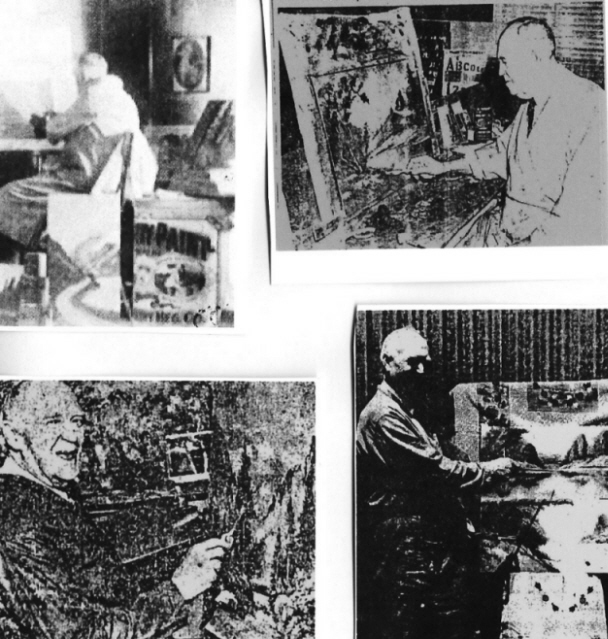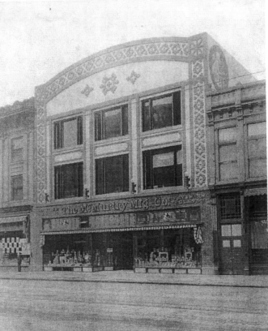

|
Early Beginnings Alvah Lincoln Browning commonly known as A. L. Browning and affectionately called "Dad" was born December 4, 1864 in Atwood, Illinois. His parents Franklyn and Angeline Browning were farmers. He had a brother and two sisters. He was raised on the farm, but farming did not appeal to him. Browning related, "My father wanted me to drive a team of mules. I never liked mules. I wanted to paint. So he said, 'You'll never amount to anything anyway. Go ahead and be a painter!" So at age sixteen, young Browning became a painter. He was self taught. His first "canvasses" were the brown paper sacks in which flour came in those days. He'd get a sack, a piece of charcoal, lie on his stomach under the maples near a stream on his fathers farm and try to capture the scene. Sometimes, he said, he'd get hold of paint left in a bucket or swipe dyes from his mother and try his hand at color. He tried to capture frost on the maples and colored rocks in the stream. The Move West Around 1899 Browning was living in Sioux City, Iowa. Shortly after his first son George was born, he divorced his first wife, Dilly. He then travelled west with his nephew, Franklyn Browning. To pay their way, they painted barns. In his spare time Alvah painted and sold landscapes. After some time, Franklyn settled near Witchita, Kansas while Browning continued traveling west. By 1914 he remarried. His wife was Helena. They had a daughter, Mary and were living in Denver, Colorado. The McMurtry Paint and Varnish Company of Denver was expanding and was building a new plant at 1533 Arapahoe Street. The building boasted two large display windows, eight by seventeen feet. It was behind one of these windows A. L. Browning would set up his artist studio. Here onlookers could stand outside watching him paint landscapes using McMurtry housepaints. The scenes were numbered with twenty six available titles available for sale to the public. They included Colorado scenes as Seven Falls, Estes Park, Lake Eldora, Big Thompson, and more. There were also scenes from other places he had traveled to through the USA and Europe. By 1916 he had moved his family to Colorado Springs where his second son, Robert was born. City directories listed his occupation as an artist. Although they first misspelled his name as Alvin. He set up a shop offering paintings for sale and continued working for the McMurtry Paint Company. From spring through summer he painted in Colorado. Then in the fall he traveled by train to Little Rock, Arkansas where he painted landscapes for the Sherwin Williams Paint Company. He used their house paints as his medium. A small flyer published by Sherwin Williams in 1944 related he had painted for them for over fifty years. While traveling between Colorado and Arkansas he would get out at he train stations. Here he would paint and sell his landscapes. Some who bought his painings remarked on how quickly he could create these paintings. Many paintings have been found at antique shops and second hand stores along this train route. Browning had traveled throughout the United States. He defied anyone to mention a sizable town in America in which he does not know someone. He had traveled in Mexico and Canada. He made three trips to Europe. On one trip he spent two years there painting. "The prettiest scenery you ever saw is the Baverian Alps," he said. One of the scenes listed on his label is titled "Alps in Switzerland." When he wasn't traveling or painting landscapes Browning taught art classes. A typical class would have a six year old boy and a seventy year old woman struggling with their first lessons. "Every person has some spark of talent," said Browning. "You don't find one in 10,000 who doesn't." One Sherwin Williams ad pointed out that he had given over three thousand instructions. Moves to California In 1923 Browning moved his family to Long Beach, California. He continued painting, teaching and travelling. The Treais Hardware Company in San Diego advertised that he would be demonstating the use of Sherwin Williams paints in the store front window. The ad said he would paint any scene from a photograph and that all of his paintings are of a scenic nature only. It went on to say that his young son Robert who is an achieving artist would accompany him. Around 1930 the Brownings spent a year in Mineral Wells, Texas. Before returning to Long Beach, A. L. Browning advertised an auction of his paintings. The auction was held at the Crazy Hotel Pavillion where he had his studio. About 250 paintings, most on canvas were auctioned. After returning to Long Beach he continued painting as well as opening an artist supply store. Sometime after this, his wife Helena passed away in death. Alvah L. Browning died December 7, 1947 while having spent a brief stay at the St. Ernie Sanitarium in Inglewood, California. Cause of death was senile dementia and heart failure. He was 83. He was survived by two sons, George and Robert, and his daughter Mary Deason. Also five grandchildren and three great grandchildren. Although his death certificate listed Katheryn as his wife at the time, his family has verified that she was not his wife. Browning once boasted he had painted 85,000 landscapes and that he had 10,000 more in his head. While this may or may not be provable, the facts show he loved painting landscapes. He painted his entire life. He said it is the only thing he ever wants to do. His devout hope was that in the next life, he can keep on painting pictures. |
||||
 The artist enjoying his work.
|
|
|||
|
|
||||
Flyer advertising the auction of over two hundred Browning paintings.
|
||||


